Analysis of the Correlation between Occupational Accidents and Economic Factors in China
Abstract
:1. Introduction
2. Materials and Methods
2.1. Changing Trend of Accidents and Economy
2.2. Construction of Index System of Accident and Economy
2.3. Accident Data Modeling and Prediction Analysis
3. Results
4. Discussion
4.1. Analysis on the Characteristics of Accidents and Economic Indicators
4.2. Research on the Change of Accident and Economic Indicators
4.3. Accident Reduction Measures Based on the Relationship between Accident and Economy
5. Conclusions
Author Contributions
Funding
Conflicts of Interest
References
- Tong, R.P.; Yang, X.S.; Zhao, H.; Parker, T.; Wang, Q.S. Process safety management in China: Progress and performance over the last 10 years and future development. Process Saf. Prog. 2020, 39, e12147. [Google Scholar] [CrossRef]
- Wang, X.B.; Wei, C.M.; He, Y.H.; Zhang, H.; Wang, Q.F. Research on the Correlation between Work Accidents and Safety Policies in China. Processes 2021, 9, 805. [Google Scholar] [CrossRef]
- Rae, A.; Provan, D.; Weber, D.; Dekker, S. Safety clutter: The accumulation and persistence of ‘safety’work that does not contribute to operational safety. Pol. Pract. Health Saf. 2018, 16, 194–211. [Google Scholar] [CrossRef]
- Miao, C.L.; Duan, M.M.; Sun, X.X.; Wu, X.Y. Safety management efficiency of China’s coal enterprises and its influencing factors—Based on the DEA-Tobit two-stage model. Process Saf. Environ. Prot. 2020, 140, 79–85. [Google Scholar] [CrossRef]
- Chen, C.; Reniers, G.; Khakzad, N.; Yang, M. Operational safety economics: Foundations, current approaches and paths for future research. Saf. Sci. 2021, 141, 105326. [Google Scholar] [CrossRef]
- Yeh, L.T. Using weighted data envelopment analysis to measure occupational safety and healthy economic performance of Taiwan’s industrial sectors. Mathematics 2020, 8, 1635. [Google Scholar] [CrossRef]
- Wei, J.C.; Lu, L.D.; Zhao, D.T.; Wang, F. Estimating the influence of the socio-economic inequalities on counties’ occupational injuries in Central China. Saf. Sci. 2016, 82, 289–300. [Google Scholar] [CrossRef]
- Mahalingam, M.; Peterson, C.; Bergen, G. Systematic review of unintentional injury prevention economic evaluations 2010-2019 and comparison to 1998–2009. Accid. Anal. Prev. 2020, 146, 105688. [Google Scholar] [CrossRef] [PubMed]
- Jenke, T.; Oosthuizen, J.; Cattani, M. An investigation of the influence of economic cycles on safety performance in Western Australia. Saf. Sci. 2021, 138, 105230. [Google Scholar] [CrossRef]
- Farina, E.; Giraudo, M.; Costa, G.; Bena, A. Injury rates and economic cycles in the Italian manufacturing sector. Occup. Med. 2018, 68, 459–463. [Google Scholar] [CrossRef] [PubMed] [Green Version]
- Boone, J.; Ours, J.; Wuellrich, J.P.; Zweimueller, J. Recessions are bad for workplace safety. J. Health Econ. 2011, 30, 764–773. [Google Scholar] [CrossRef] [PubMed] [Green Version]
- Fuente, V.; Lopez, M.A.; Gonzalez, I.; Alcantara, O.J.; Ritzel, D.O. The impact of the economic crisis on occupational injuries. J. Saf. Res. 2014, 48, 77–85. [Google Scholar] [CrossRef] [PubMed]
- Lyszczarz, B.; Nojszewska, E. Economic situation and occupational accidents in Poland: 2002–2014 panel data regional study. Int. J. Occup. Med. Environ. Health 2017, 31, 151–164. [Google Scholar] [CrossRef] [PubMed]
- Mouza, A.M.; Targoutzidis, A. The impact of the economic cycle on fatal injuries. The case of UK 1971–2007. Qual. Quant. 2012, 46, 1917–1929. [Google Scholar] [CrossRef]
- Song, L.; He, X.Q.; Li, C.W. Longitudinal relationship between economic development and occupational accidents in China. Accid. Anal. Prev. 2011, 43, 82–86. [Google Scholar] [CrossRef]
- Fernandez-Muniz, B.; Montes-Peon, J.; Vazquez-Ordas, C. Occupational accidents and the economic cycle in Spain 1994–2014. Saf. Sci. 2018, 106, 273–284. [Google Scholar] [CrossRef]
- Mrema, E.J.; Ngowi, A.V.; Mamuya, S.H.D. Status of occupational health and safety and related challenges in expanding economy of Tanzania. Ann. Glob. Health 2015, 81, 538–547. [Google Scholar] [CrossRef] [Green Version]
- Kahraman, E.; Akay, O.; Kilic, A.M. Investigation into the relationship between fatal work accidents, national income, and employment rate in developed and developing countries. J. Occup. Health 2019, 61, 213–218. [Google Scholar] [CrossRef]
- Moniruzzaman, S.; Andersson, R. Economic development as a determinant of injury mortality—A longitudinal approach. Soc. Sci. Med. 2008, 66, 1699–1708. [Google Scholar] [CrossRef]
- Wu, W.T.; Liang, S.Y.; Liu, R.H.; Jin, W.Z.; Ma, C.X. Economic development, demographic characteristics, road network and traffic accidents in Zhongshan, China: Gradient boosting decision tree model. Transp. A 2020, 16, 359–387. [Google Scholar] [CrossRef]
- Chen, T.; Cao, Z.H. Construction safety: An analysis of the cross-influence of economic, construction, and accident death factors. Sci. Pollut. Res. 2021, 6, 1–12. [Google Scholar]
- Hola, B.; Nowobilski, T. Analysis of the influence of socio-economic factors on occupational safety in the construction industry. Sustainability 2019, 11, 4469. [Google Scholar] [CrossRef] [Green Version]
- Forteza, F.J.; Carretero-Gomez, J.; Sese, A. Occupational risks, accidents on sites and economic performance of construction firms. Saf. Sci. 2017, 94, 61–76. [Google Scholar] [CrossRef]
- Xu, Q.W.; Xu, K.L. Analysis of the characteristics of fatal abetaidents in the construction industry in China based on statistical data. Int. J. Environ. Res. Public Health 2021, 18, 2162. [Google Scholar] [CrossRef]
- Liu, T.M.; Zhong, M.H.; Xing, J.J. Industrial accidents: Challenges for China’s economic and social development. Saf. Sci. 2005, 43, 503–522. [Google Scholar] [CrossRef]
- Tan, H.X.; Wang, H.T.; Chen, L.; Ren, H.L. Empirical analysis on contribution share of safety investment to economic growth: A case study of Chinese mining industry. Saf. Sci. 2012, 50, 1472–1479. [Google Scholar] [CrossRef]
- Kim, D.K.; Park, S. Business cycle and occupational accidents in Korea. Saf. Health Work. 2020, 11, 314–321. [Google Scholar] [CrossRef]
- Li, X.B.; Liu, J.; Zhou, J.; Liu, X.L.; Zhou, L.; Wei, W. The effects of macroeconomic factors on road traffic safety: A study based on the ARDL-ECM model. Sustainability 2020, 12, 10262. [Google Scholar] [CrossRef]
- Paulozzi, L.J.; Ryan, G.W.; Espitia-Hardeman, V.E.; Xi, Y.L. Economic development’s effect on road transport-related mortality among different types of road users: A cross-sectional international study. Accid. Anal. Prev. 2007, 39, 606–617. [Google Scholar] [CrossRef]
- Sun, L.L.; Liu, D.; Chen, T.; Meng, T. Analysis on the accident casualties influenced by several economic factors basedon the traffic-related data in China from 2004 to 2016. Chin. J. Traumatol. 2019, 22, 75–79. [Google Scholar] [CrossRef]
- Rojo, M.; Gonzalo-Orden, H.; Linares, A.; dell’Olio, L. Impact of a lower conservation budget on road safety indices. J. Adv. Transp. 2018, 2018, 9570465. [Google Scholar] [CrossRef]
- Garcia-Ferrer, A.; Bujosa, M.; Sanchez-Mangas, R. Revisiting the relationship between traffic accidents, real economic activity and other factors in Spain. Accid. Anal. Prev. 2020, 144, 105549. [Google Scholar] [CrossRef] [PubMed]
- Law, T.H.; Noland, R.B.; Evans, A.W. Factors associated with the relationship between motorcycle deaths and economic growth. Accid. Anal. Prev. 2009, 41, 234–240. [Google Scholar] [CrossRef] [PubMed]
- Li, X.; Wu, L.Y.; Zhao, D.; Yang, X.F. Exploring the impact of social economic variables on traffic safety performance in Hong Kong: A time series analysis. Saf. Sci. 2018, 109, 67–75. [Google Scholar] [CrossRef]
- Bougueroua, M.; Carnis, L. Economic Development, mobility and traffic accidents in Algeria. Accid. Anal. Prev. 2016, 92, 168–174. [Google Scholar] [CrossRef]
- Traynor, T.L. Regional economic conditions and crash fatality rates—A cross-county analysis. J. Saf. Res. 2008, 39, 33–39. [Google Scholar] [CrossRef]
- Khalid, U.; Sagoo, A.; Benachir, M. Safety Management System (SMS) framework development—Mitigating the critical safety factors affecting Health and Safety performance in construction projects. Saf. Sci. 2021, 143, 105402. [Google Scholar] [CrossRef]
- Ariani, F.; Baldasseroni, A.; Biffino, M.; Romeo, G.; Levi, M. Reassessment of burden of occupational fatal injuries in Italy, 1951–2017. Epidemiol. Prev. 2020, 44, 263–270. [Google Scholar]
- Zhang, L.; Luo, Y.; Xu, M.; Wang, G.T.; Liang, W.; Xiang, Y. Relative Risk of High-Danger Industries in China from 2004 to 2016. Int. J. Environ. Res. Public Health 2020, 17, 3017. [Google Scholar] [CrossRef]
- National Bureau of Statistics. China Statistical Yearbook; China Statistics Press: Beijing, China, 2020; pp. 4–16.
- Ministry of Emergency Management. China’s Work Safety Yearbook; China Coal Industry Press: Beijing, China, 2018; pp. 416–424.
- Yuan, Z.H.; Yang, X.; Martínez-Aires, M. A reference framework for health and safety in the workplace in China and the European Union: A comparative study. Work 2021, 4, 1–15. [Google Scholar]
- Liang, K.; Fung, I. The impact of macroeconomic and industrial fluctuation on fatalities of construction workers in China. J. Saf. Res. 2019, 70, 149–158. [Google Scholar] [CrossRef]
- Xu, N.; Ma, L.; Liu, Q.; Wang, L.; Deng, Y.L. An improved text mining approach to extract safety risk factors from construction accident reports. Saf. Sci. 2021, 138, 105216. [Google Scholar] [CrossRef]
- Blanton, R.G.; Peksen, D. Dying for globalization? The impact of economic globalization on industrial accidents. Soc. Sci. Q. 2017, 98, 1487–1502. [Google Scholar] [CrossRef]
- Patriarca, R.; Bergstrom, J.; Di Gravio, G.; Costantino, F. Resilience Engineering: Current status of the research and future challenges. Saf. Sci. 2018, 102, 79–100. [Google Scholar] [CrossRef]
- Mannan, M.S.; Reyes-Valdes, O.; Jain, P.; Tamim, N. The Evolution of Process Safety: Current Status and Future Direction. Annu. Rev. Chem. Biomol. Eng. 2016, 82, 289–300. [Google Scholar] [CrossRef] [PubMed]
- Pu, H.X.; Li, B.; Luo, D.Q.; Wang, S.B.; Wang, Z.L.; Zhao, W.; Zheng, L.Y.; Duan, P. Impact of urbanization factors on mortality due to unintentional injuries using panel data regression model and spatial-temporal analysis. Environ. Sci. Pollut. Res. 2020, 27, 2945–2954. [Google Scholar] [CrossRef] [PubMed]
- Rydell, A.; Andersson, I.M.; Bernsand, C.O.; Rosen, G. Work environment investments: Critical elements for success in optimizing occupational health and safety effects. Work 2019, 64, 107–116. [Google Scholar] [CrossRef] [PubMed] [Green Version]
- Wang, X.; Du, J.; Zhuang, Z.; Wang, Z.G.; Jiang, J.X.; Yang, C. Incidence, casualties and risk characteristics of civilian explosion blast injury in China: 2000-2017 data from the state Administration of Work Safety. Mil. Med. Res. 2020, 7, 29. [Google Scholar] [CrossRef] [PubMed]
- de Sant’Anna, D.A.L.M.; de Hilal, A.V.G. The impact of human factors on pilots’ safety behavior in offshore aviation companies: A brazilian case. Saf. Sci. 2021, 140, 105272. [Google Scholar] [CrossRef]
- Wei, J.C.; Zhou, L.; Wang, F.; Wu, D.S. Work safety evaluation in Mainland China using grey theory. Appl. Math. Model. 2015, 39, 924–933. [Google Scholar] [CrossRef]
- Wang, R.J.; Xu, K.L.; Xu, Y.Y.; Wu, Y.J. Study on prediction model of hazardous chemical accidents. J. Loss Prev. Process Ind. 2020, 66, 104183. [Google Scholar] [CrossRef]
- Ai, X.B.; Hu, Y.Z.; Chen, G.H. A systematic approach to identify the hierarchical structure of accident factors with grey relations. Saf. Sci. 2014, 63, 83–93. [Google Scholar] [CrossRef]
- Acir, A.; Canli, M.E.; Ata, I.; Cakiroglu, R. Parametric optimization of energy and exergy analyses of a novel solar air heater with grey relational analysis. Appl. Therm. Eng. 2017, 122, 330–338. [Google Scholar] [CrossRef]
- Li, C.P.; Qin, J.X.; Li, J.J.; Hou, Q. The accident early warning system for iron and steel enterprises based on combination weighting and Grey Prediction Model GM (1,1). Saf. Sci. 2016, 89, 19–27. [Google Scholar] [CrossRef]
- Goncalves, A.P.G.; Waterson, P.; Jun, G.T. Improving accident analysis in construction—Development of a contributing factor classification framework and evaluation of its validity and reliability. Saf. Sci. 2021, 140, 105303. [Google Scholar] [CrossRef]
- Ismail, S.N.; Ramli, A.; Aziz, H.A. Research trends in mining accidents study: A systematic literature review. Saf. Sci. 2021, 143, 105438. [Google Scholar] [CrossRef]
- Khahro, S.H.; Ali, T.H.; Memon, N.A.; Memon, Z.A. Occupational accidents: A comparative study of construction and manufacturing industries. Curr. Sci. 2020, 118, 243–248. [Google Scholar]
- Li, S.Q.; Wu, X.Y.; Wang, X.Z.; Hu, S.H. Relationship between Social Capital, Safety Competency, and Safety Behaviors of Construction Workers. J. Constr. Eng. Manag. 2020, 146, 04020059. [Google Scholar] [CrossRef]
- Yang, L.; Birhane, G.E.; Zhu, J.Q.; Geng, J.C. Mining Employees Safety and the Application of Information Technology in Coal Mining: Review. Front. Public Health 2021, 9, 709987. [Google Scholar] [CrossRef]
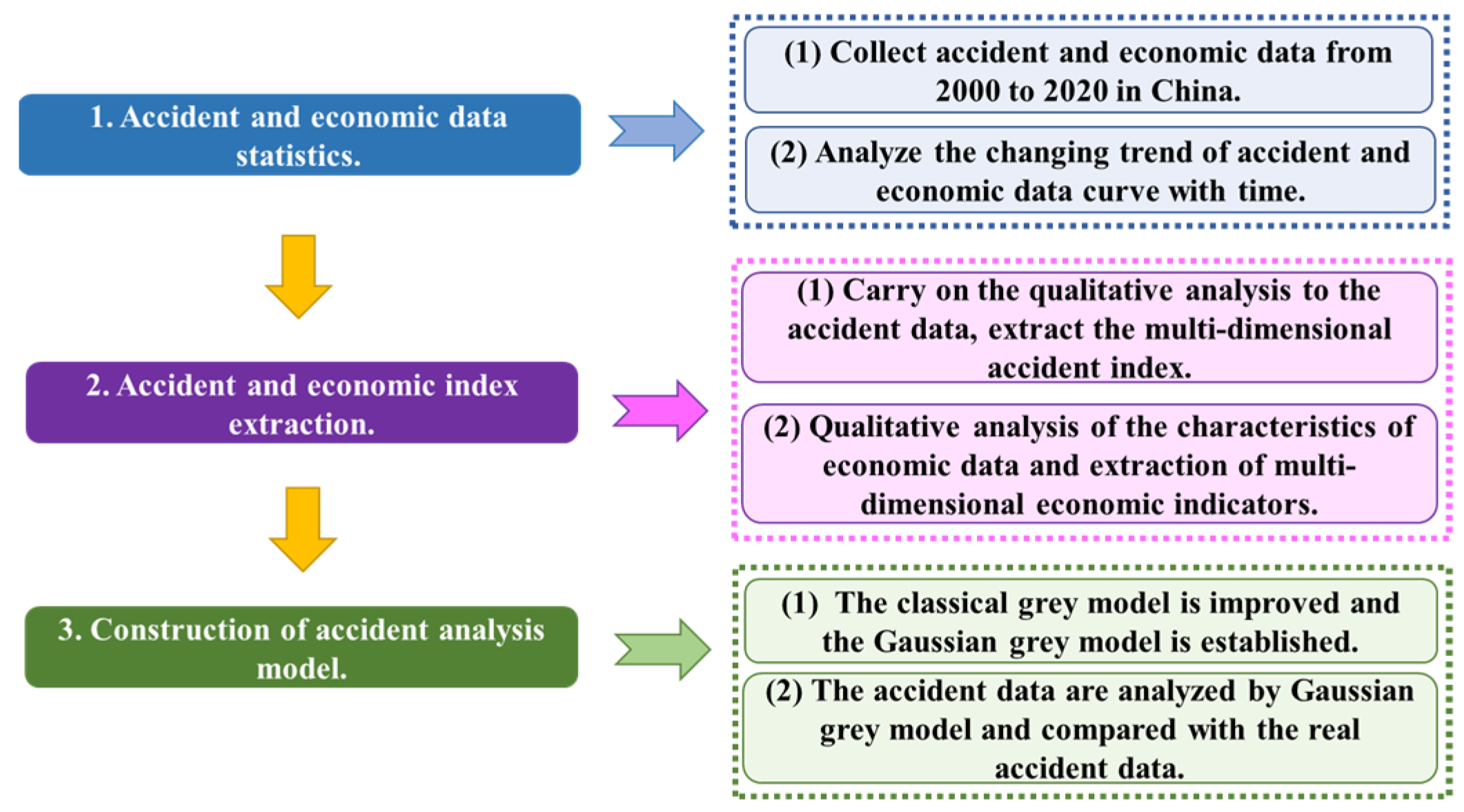
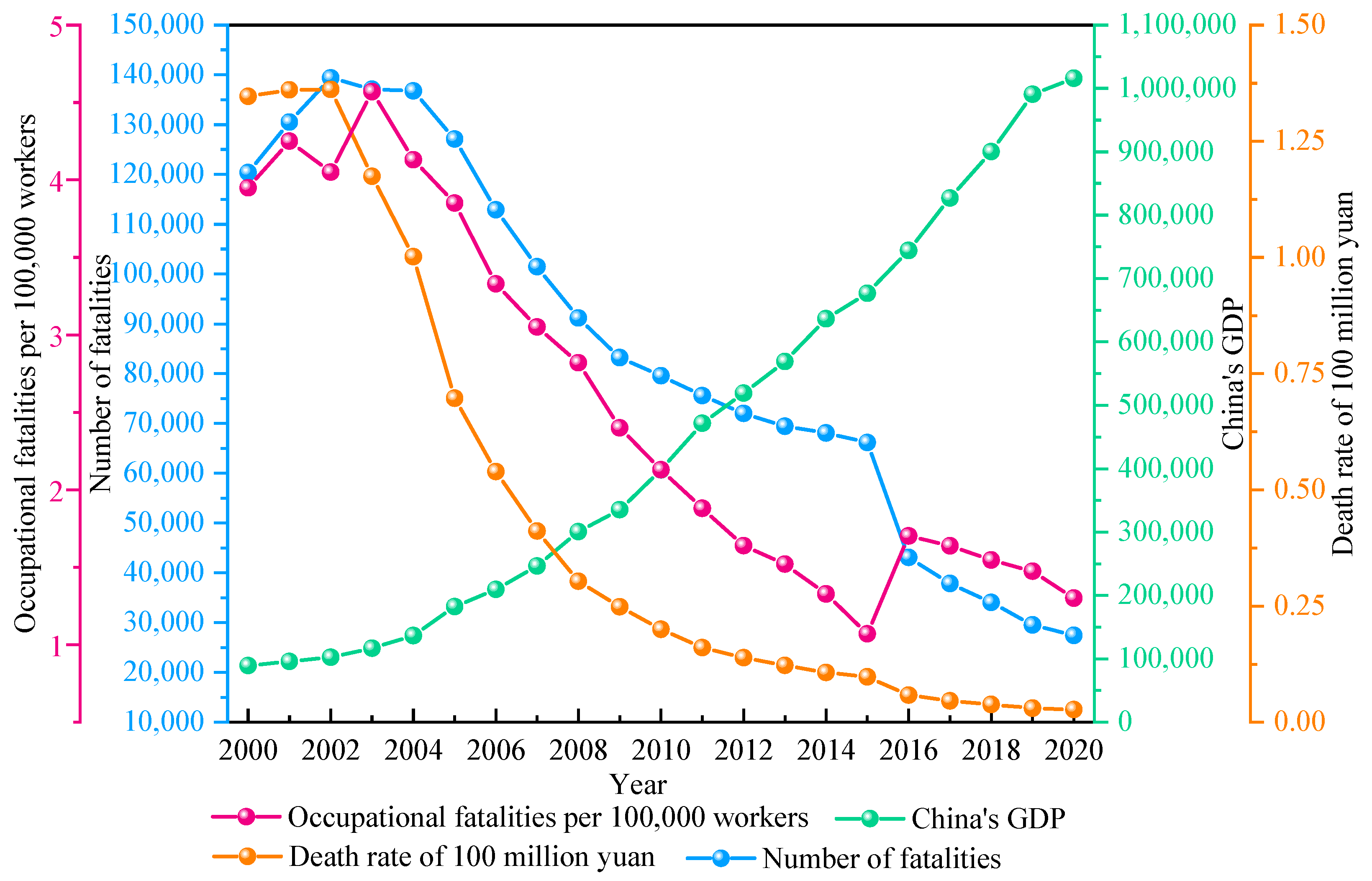

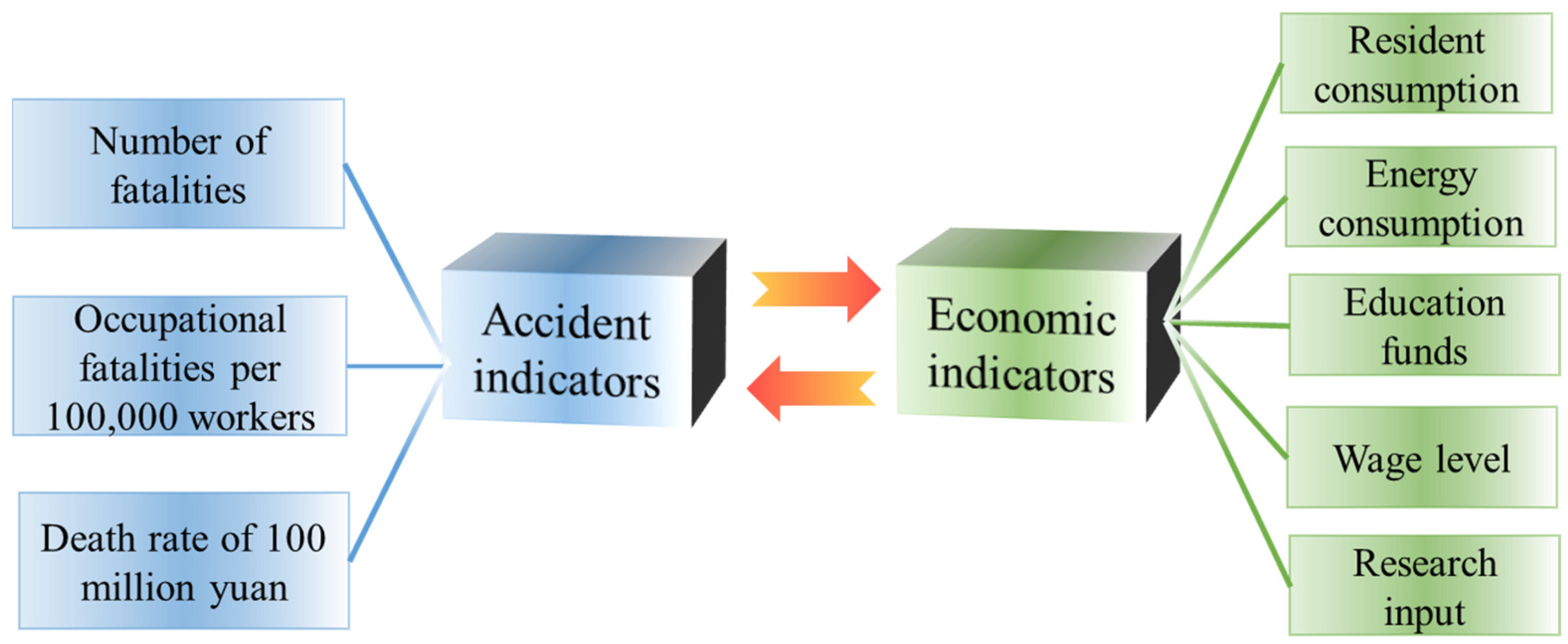
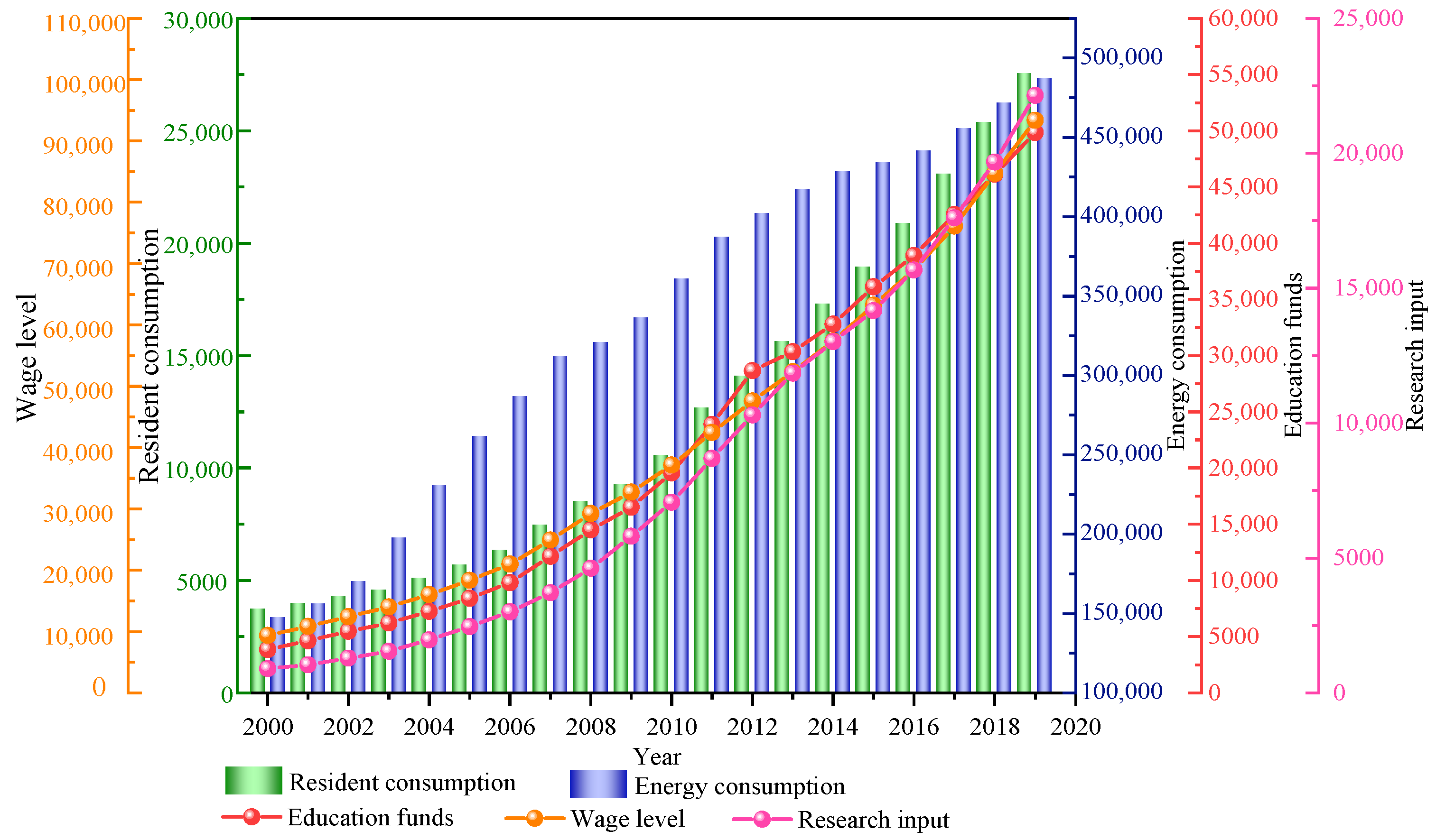

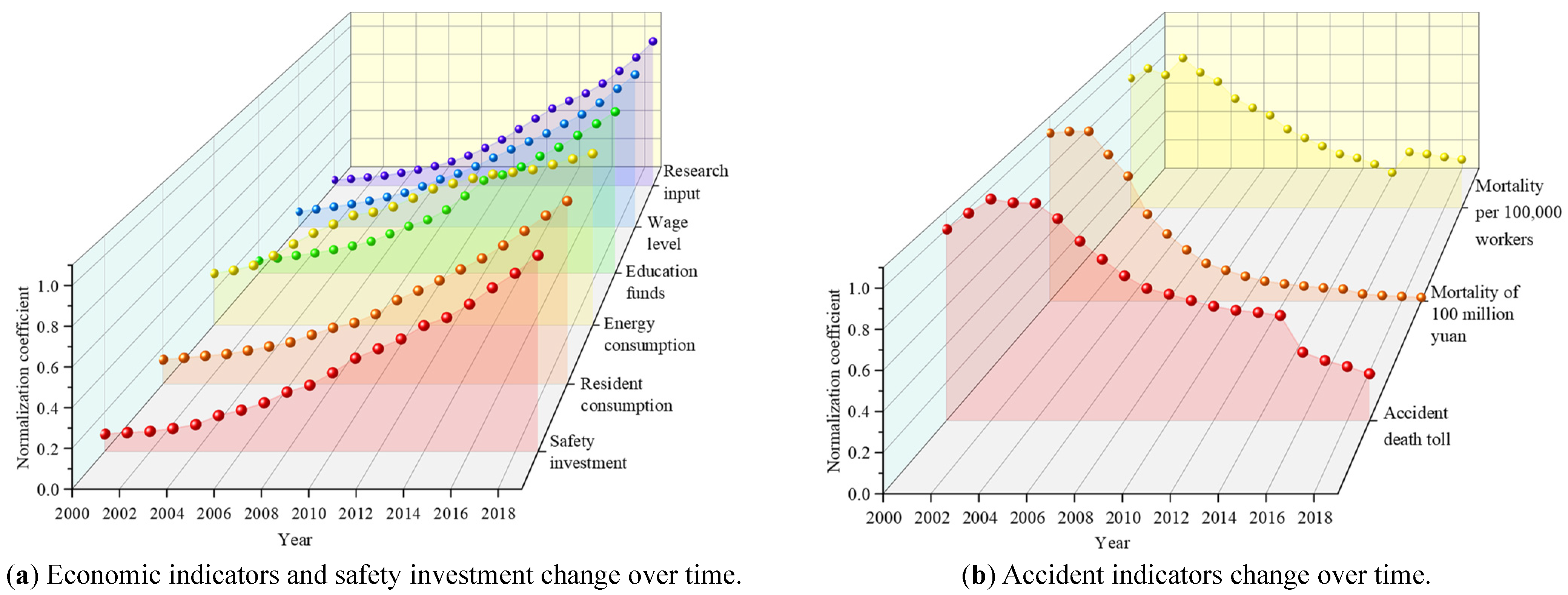
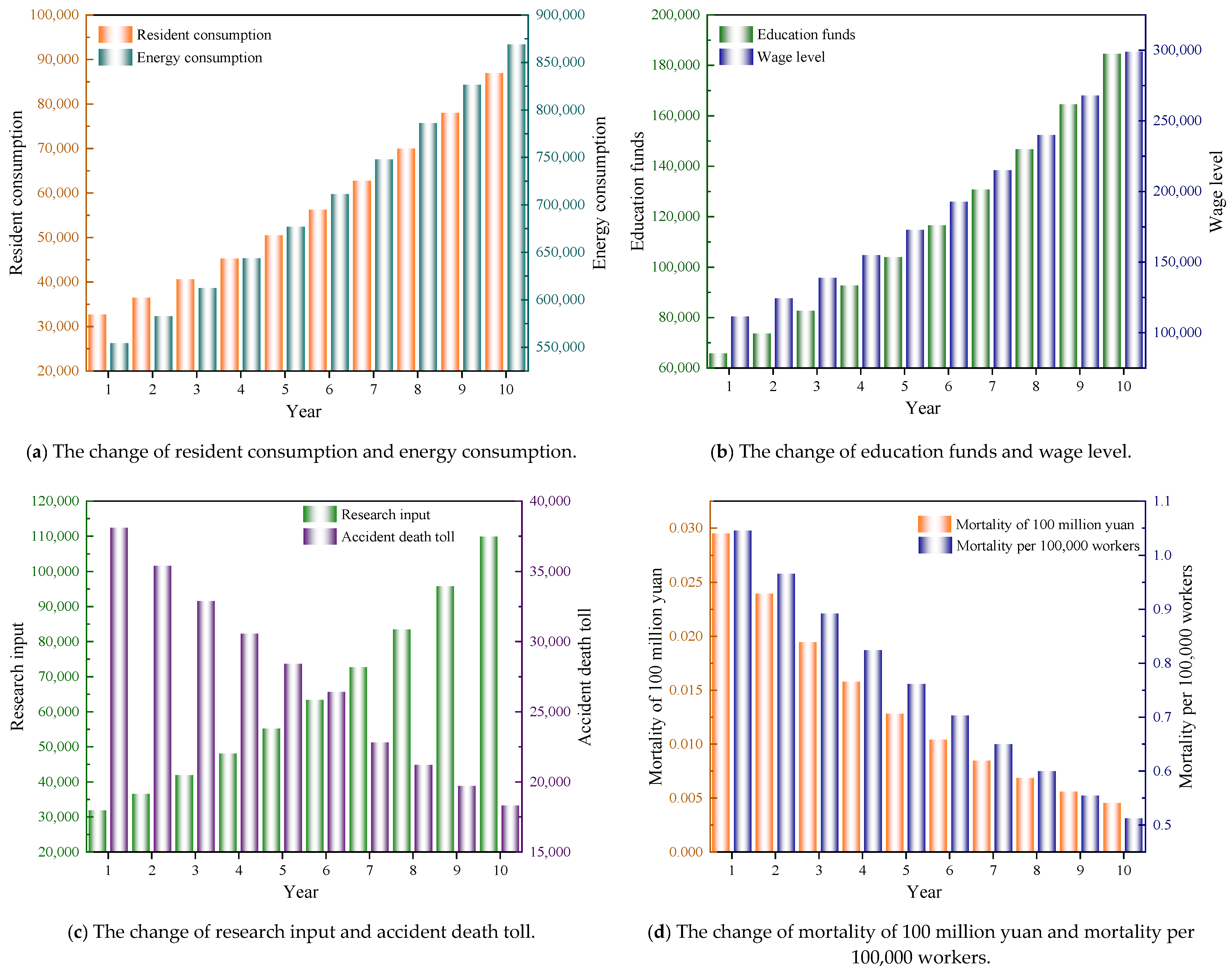
| Year | True Value | GM(1, 1) Predicted Value | GM(1, 1) Relative Error | GGM(1, 1) Predicted Value | GGM(1, 1) Relative Error |
|---|---|---|---|---|---|
| 2000 | 120,351 | 120,350.239 | −0.000006 | 120,398.833 | −0.000037 |
| 2001 | 130,491 | 153,846.738 | 0.151812 | 130,893.063 | −0.003072 |
| 2002 | 139,393 | 142,948.842 | 0.024875 | 137,745.544 | 0.011960 |
| 2003 | 137,070 | 132,822.911 | –0.031976 | 139,394.868 | −0.016678 |
| 2004 | 136,755 | 123,414.260 | −0.108097 | 135,349.481 | 0.010384 |
| 2005 | 127,089 | 114,672.081 | −0.108282 | 126,393.027 | 0.005506 |
| 2006 | 112,879 | 106,549.164 | −0.059408 | 114,390.916 | −0.013217 |
| 2007 | 101,480 | 99,001.642 | −0.025034 | 101,753.681 | −0.002690 |
| 2008 | 91,172 | 91,988.756 | 0.008879 | 90,729.347 | 0.004879 |
| 2009 | 83,200 | 85,472.636 | 0.026589 | 82,756.006 | 0.005365 |
| 2010 | 79,552 | 79,418.092 | −0.001686 | 78,086.517 | 0.018767 |
| 2011 | 75,572 | 73,792.428 | −0.024116 | 75,806.112 | −0.003088 |
| 2012 | 71,983 | 68,565.264 | −0.049846 | 74,231.713 | −0.030293 |
| 2013 | 69,434 | 63,708.371 | −0.089872 | 71,554.045 | −0.029629 |
| 2014 | 68,061 | 59,195.522 | −0.149766 | 66,503.627 | 0.023418 |
| 2015 | 66,182 | 55,002.345 | −0.203258 | 63,816.640 | 0.037065 |
| 2016 | 43,062 | 51,106.196 | 0.157402 | 44,347.675 | −0.028991 |
| 2017 | 37,852 | 47,486.035 | 0.202881 | 39,798.570 | −0.048911 |
| 2018 | 34,046 | 44,122.311 | 0.228372 | 32,863.764 | 0.035974 |
| 2019 | 29,519 | 40,996.861 | 0.279969 | 29,087.441 | 0.014837 |
| 2020 | 27,412 | 38,092.805 | 0.280389 | 27,954.130 | −0.019394 |
| Resident Consumption | Energy Consumption | Education Funds | Wage Level | Research Input | |
|---|---|---|---|---|---|
| 1. Accident death toll (γi) | 0.766539 | 0.669142 | 0.742253 | 0.749791 | 0.769856 |
| 2. Mortality of 100 million yuan (γi) | 0.729998 | 0.623648 | 0.722355 | 0.723761 | 0.757859 |
| 3. Mortality per 100,000 workers (γi) | 0.75478 | 0.647696 | 0.735713 | 0.741025 | 0.766227 |
| 4. Comprehensive accident index (γi) | 0.750439 | 0.646829 | 0.73344 | 0.738192 | 0.764647 |
| 5. Accident death toll (εi) | 0.956225 | 0.955454 | 0.963937 | 0.962162 | 0.963653 |
| 6. Mortality of 100 million yuan (εi) | 0.797445 | 0.79676 | 0.827531 | 0.818164 | 0.862573 |
| 7. Mortality per 100,000 workers (εi) | 0.865659 | 0.870746 | 0.898157 | 0.876959 | 0.914696 |
| 8. Comprehensive accident index (εi) | 0.87311 | 0.87432 | 0.896542 | 0.885761 | 0.916307 |
| 9. Accident death toll (ρi) | 0.861382 | 0.810398 | 0.853095 | 0.855976 | 0.862655 |
| 10. Mortality of 100 million yuan (ρi) | 0.763721 | 0.79311 | 0.774943 | 0.770962 | 0.777309 |
| 11. Mortality per 100,000 workers (ρi) | 0.81022 | 0.801196 | 0.816935 | 0.808992 | 0.818486 |
| 12. Comprehensive accident index (ρi) | 0.811774 | 0.801568 | 0.814991 | 0.811977 | 0.819484 |
Publisher’s Note: MDPI stays neutral with regard to jurisdictional claims in published maps and institutional affiliations. |
© 2021 by the authors. Licensee MDPI, Basel, Switzerland. This article is an open access article distributed under the terms and conditions of the Creative Commons Attribution (CC BY) license (https://creativecommons.org/licenses/by/4.0/).
Share and Cite
Li, C.; Wang, X.; Wei, C.; Hao, M.; Qiao, Z.; He, Y. Analysis of the Correlation between Occupational Accidents and Economic Factors in China. Int. J. Environ. Res. Public Health 2021, 18, 10781. https://doi.org/10.3390/ijerph182010781
Li C, Wang X, Wei C, Hao M, Qiao Z, He Y. Analysis of the Correlation between Occupational Accidents and Economic Factors in China. International Journal of Environmental Research and Public Health. 2021; 18(20):10781. https://doi.org/10.3390/ijerph182010781
Chicago/Turabian StyleLi, Chengwu, Xiangbing Wang, Chengmin Wei, Min Hao, Zhen Qiao, and Yonghang He. 2021. "Analysis of the Correlation between Occupational Accidents and Economic Factors in China" International Journal of Environmental Research and Public Health 18, no. 20: 10781. https://doi.org/10.3390/ijerph182010781
APA StyleLi, C., Wang, X., Wei, C., Hao, M., Qiao, Z., & He, Y. (2021). Analysis of the Correlation between Occupational Accidents and Economic Factors in China. International Journal of Environmental Research and Public Health, 18(20), 10781. https://doi.org/10.3390/ijerph182010781






